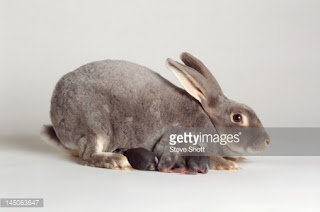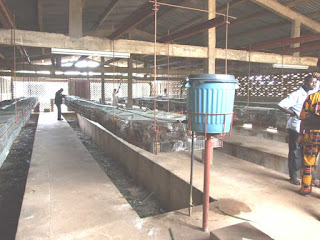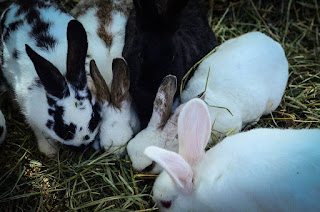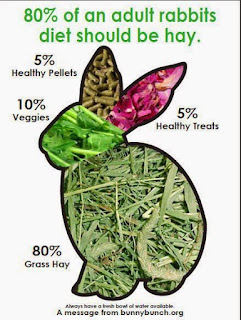FEEDING BEHAVIOUR OF RABBITS
In this article I will highlight what influences milk intake, solid feed intake, feed composition, restricted mode of feeding, hunger and thirst, feeding behavior in young and adult rabbits and restricted access to drinking water. The results of the research conducted by: Dr. Zsolt Szendro, Dr. Zsolt Matics, and Dr. Zsolt Gerencsér explains these factors that influence how rabbits feed.
Milk intake
Females give birth to naked and blind young in a nest after 31-32 days of gestation.
Initial nursing occurs during parturition. Suckling is induced by the mother when she stands motionless over the kits in the nest. She gives no direct association to the offspring to suck.
The nipple-searching behavior is very stereotyped and controlled by a pheromonal signal.
Most of the rabbits suckle their litter for 3-5 min once a day but some does nurse their kits twice a day. If two different females are presented to the litter the young are able to suckle twice a day.
During suckling, competition for access to nipples is very high. Kits do not appropriate a single nipple but change from one to another every 20 seconds within the same suckling bout.
During the first week post-partum, kits drink about 15% of their body weight in milk each day in one nursing session and up to 25% for some individuals. Individual milk intake increases gradually to reach a peak of about 25 g/day.
After day 20-25, maternal milk production progressively decreases. If the female is fertilized just after parturition, and sustains a concurrent pregnancy and lactation, milk production decrease significantly at the end of pregnancy and ceases 2-3 days before the following parturition.
Solid feed intake
Young rabbits begin to eat significant quantities of solid food at around 16-18 days of age, when they are able to leave the nest to access a feeder and drinker.
The solid food intake increases from 25 days of age to reach 40-50 g/day by 35 days.
The feeding behaviour changes considerably in a few days, as the young switch from a single daily meal of milk to 25-30 solid and water meals in 24 h.
Solid feed intake and evaluation of nutrient and energy supply
In parallel to modifications in feeding behavior, the nutrients ingested by young rabbits
In parallel to modifications in feeding behavior, the nutrients ingested by young rabbits
change significantly between birth and weaning.
Rabbit milk is very rich in:
- Lipids (13%),
- Proteins (12%),
- contains only traces of lactose.
- Carbohydrates (8%), with varying digestibility ranging from very high for starch to low for fibre.
- Protein (15-18%),
- Small quantity of lipids (3-5%) all of vegetable origin.
Digestive capacities must evolve rapidly, parallel with the evolution of feeding patterns.
The ingestion of vegetable proteins becomes equal to that from milk at around 25 days of age, and then exceeds it within few days.
Lipids come mainly from milk until weaning.
Ingestion of carbohydrates is virtually zero until 17 days of age; it becomes significant from day 21 in the form of fibre and starch.
Regulation of feeding behavior in young rabbits
The availability of milk is a key regulating factor of solid food ingestion before weaning.
The availability of milk is a key regulating factor of solid food ingestion before weaning.
Early weaning (before 25 days of age) stimulates and considerably accelerates dry feed
intake.
Suckling rabbits regulate their food consumption according to DE content, as do weaned rabbits.
Feeding behavior of the growing rabbit
From weaning, the daily feed intake of rabbits increases in relation to metabolic LW, and stabilized at about 5 months of age (140-150 g DM/day).
The intake of soft faeces increases until 2 months of age and then remains steady. Expressed as fresh matter the intake of soft faeces increases from 10 g/day (1 month old) to 35 g/day (2 months), thus representing 15-35% of the feed intake.
Feeding behavior of the growing and adult rabbit
The rabbit divides its voluntary solid intake into numerous meals: about 40 at 6 weeks of age, and a slightly lower number in adulthood. The number of liquid meals increases in parallel to that feed and less time is spent drinking than eating. The normal ratio of water to DM is about 1.6-1.8. In the adult or breeding doe it is increased up to 2.0-2.1.
The rabbit divides its voluntary solid intake into numerous meals: about 40 at 6 weeks of age, and a slightly lower number in adulthood. The number of liquid meals increases in parallel to that feed and less time is spent drinking than eating. The normal ratio of water to DM is about 1.6-1.8. In the adult or breeding doe it is increased up to 2.0-2.1.
The solid feed is consumed in the dark period for rabbit submitted to a 12-h light, 12-h dark schedule.
The circadian changes in liquid meals are strictly parallel to those of solid meals for rabbit fed pellets.
With older rabbits, the nocturnal feeding behavior becomes more pronounced.
With older rabbits, the nocturnal feeding behavior becomes more pronounced.
Feeding behaviour of the adult rabbit
The feed intake level is modulated by the physiological status of doe. The voluntary intake of does varies during the reproductive cycle, with intake falling markedly during the final days of pregnancy. Some does refuse solid food just before kindling. Water intake, however, never stops completely. After kindling, feed intake increases very rapidly and can exceed 100 g DM/kg LW/day. Water intake is also increased at that time, from 200 to 250 g/kg LW.
Feeding composition and presentation form
The rabbit (feed a pelleted balanced diet) is able to regulate its DE intake when the dietary DE concentration is between 9 and 11.5 MJ/kg, or when the dietary fibre level is between 10% and 25% DF. The intake level is thus well correlated with the dietary fibre level, compared to the dietary DE content.
Environmental factors affecting the feeding behaviour of the rabbit
Temperature
Studies on growing rabbits have shown that the intake of pelleted feed drops from 180 to 120 g/day and water intake rises from 330 to 390 g/day at temperature between 5°C and 30°C.
The number of solid meals eaten in 24h drops as temperature increases, from 37 solid feeds at 10°C to 27 feeds at 30°C.
The amount eaten at each meal also decreases with higher temperature (from 5.7 g per meal
The amount eaten at each meal also decreases with higher temperature (from 5.7 g per meal
at 10-20°C to 4.4 g per meal at 30°C).
The negative effect of hot ambient temperature on daily feed intake may be partly counterbalanced by distribution of cooler drinking water (16-20°C). With cold water distribution, the average feed intake may be increased by 4-6%.
Hunger and thirst
If drinking water is not provided and the only feed available is dry (moisture content of 14%), DM intake drops to zero within 24h. With no water at all an adult rabbit can survive from 4 to 8 days. Rabbits with access to drinking water but no solid feed can survive for 3-4 weeks.
Any reduction in the water supply causes a proportional reduction in DM intake, with a consequent drop on most performance criteria.
Limiting water availability for breeding does to 20 min/day decreases their feed intake, milk production and growth of kits by about 17-18%, but has no effect on reproduction parameters and kit mortality.
Limiting water availability for breeding does to 20 min/day decreases their feed intake, milk production and growth of kits by about 17-18%, but has no effect on reproduction parameters and kit mortality.
Environmental factors
Lighting schedule
In the absence of light (24-h dark) the feed intake of fattening rabbits is increased.
Rabbits organize their feeding pattern in a regular 23.3- to 23.8-h programme, with about 5-6h devoted to soft faeces ingestion and the remaining part of the cycle to feed intake.
Under continuous lighting, the feeding pattern is organized in approx. 25-h programme.11.2. Stocking density
Under continuous lighting, the feeding pattern is organized in approx. 25-h programme.11.2. Stocking density
An increase in stocking density seems to lead to reduced feed intake. 11.3. Group size
In comparison of cage and pen housing, enlarging the cage size for a group allows rabbits to move more and reduces daily feed intake. 11.4. Size of feeder
The number of places at a feeder (one to six) for a group of ten rabbits did not influence daily feed intake.
Free choice of rabbits
When a choice is proposed between a control diet and the same diet plus as appetizer, rabbits generally prefer the latter. Rabbit prefer lucerne with a saponin (a bitter component) content of up to 3 mg/g diet.
When a toxin is present (e.g. aflatoxin) rabbits completely refuse to consume the diet or consume it in very low quantities. This regulation may be relevant in protecting the animal against food-borne pathologies.
When a concentrate (low-fibre compound diet) and a fibrous material are offered as free choice to rabbits, they prefer the former.
Receiving a diet deficient in one essential amino acid (lysine or sulphur amino acids) and
drinking water with or without the missing amino acid in solution clearly prefer the
solution with the missing amino acid.
Feed restriction
Quantitative limitation
For rabbits a quantity representing 85% of the ad libitum of 16 h; if the quantity is reduced to 70%, the time taken to ingest this quantity is reduced to 10 h. When restricted-fed rabbits are caged in groups, the time spent on feed intake is shorter. 13.2. Restricted access to the feeder
Feed restriction to 8 h/day was associated with a reduction in feed intake of 80% of ad libitum. Reducing access time to feeders induces a greater reduction in the intake of young rabbits than in older fattening rabbits.
The total number of meals per day is not affected by time limitation (30-35/day at 12
weeks) but the meals are concentrated in the smaller number of hours available, without a
significant increase in the duration of each meal.
Restricted access to drinking water
Limitation of the access time to drinkers is another method by which to reduce feed intake.
After a week of adaptation, rabbits receiving free access to drinking water for only 10 min/day reduced their feed intake to 76-86% of that of rabbits drinking ad libitum.
The adaptation period was introduced because of the drastic reductions in water and feed intake (-63% and - 53%. resp.) in the 1-2 days following the institution of the restriction.
In practical conditions with fattening rabbits, limiting access to drinking water to 1.5-4 h induces a reduction in water intake that is proportionally greater than the concomitant reduction in pelleted feed intake.
With restricted access to drinkers, the water to feed ratio is always reduced.
When feed intake is reduced, the water intake is clearly enhance above the ad libitum intake, and the water to feed ratio is increased above that of the control.
With restricted access to drinkers, the water to feed ratio is always reduced.
When feed intake is reduced, the water intake is clearly enhance above the ad libitum intake, and the water to feed ratio is increased above that of the control.





